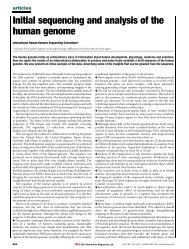2006. évi 1. szám - Jura - Pécsi Tudományegyetem
2006. évi 1. szám - Jura - Pécsi Tudományegyetem
2006. évi 1. szám - Jura - Pécsi Tudományegyetem
Create successful ePaper yourself
Turn your PDF publications into a flip-book with our unique Google optimized e-Paper software.
Kitti Maros: Research on peyotism from a legal anthropological aspect<br />
79<br />
dwells” (Boyd). Moreover, the Messenger Bird is<br />
also considered as the integrated part of the Messenger<br />
Power, “who is the unifying force between...<br />
the Spirit Powers,..the Earth and Spirit Power and<br />
Sun Power “ (Boyd).<br />
In the postmeridian, the participants tend to<br />
“smoke the sacred pipe or cigarettes, sings and prays,<br />
and drops into euphoric contemplation” (Boyd), as<br />
“only four songs have to be sung at fixed times: the<br />
Opening Song, The Midnight Water Call, the Morning<br />
Water Call, and the Closing Song” (Stewart). It<br />
is the time of individual communion with the Spirit<br />
Powers whence “the door beauty opens, and the<br />
member passes trough; an inanimate plant may become<br />
suddenly alive, writhing in colorful greens...<br />
supernatural power fills the lodge as twisting figures<br />
ride with the smoke of the fire” (Boyd). Humphry<br />
Osmond gives an account of a peyote night narrating<br />
“there was a ghost of brilliant color in my eye<br />
grounds when I closed my lips, I felt remote and<br />
slightly depressed, the roof flap fluttered like a lost<br />
soul, the teepee is the microcosm, a tiny mirror of the<br />
universe” (Osmond). Havelock Ellis claims to experience<br />
similar visions induced by peyote ingestion in<br />
a non-ritual peyote rite, moreover, describes if so<br />
“the mescal produces exactly the same conditions of<br />
visual hyperesthesia, or rather exhaustion, as may be<br />
produced on the artist by the influence of prolonged<br />
visual attention” (Ellis).<br />
Reports on extra-carnal experience were collected:<br />
“more than once during a ceremony I suddenly felt<br />
as though I had left my body, passing into a person<br />
sitting across from me and looking through his eyes<br />
at me” (Morgan). Moreover, it is interesting to note<br />
inasmuch as a non-native uses peyote within the<br />
context of non-ritual peyote ceremony, the perceived<br />
auditory and visual hallucinations are strongly related<br />
to Indian symbolism (Nagy-Lovass ).<br />
The next phase of the ritual commences at midnight;<br />
the ritual is suspended for a short period of<br />
time, the Water Woman is called and “after receiving<br />
a prayer of blessing from the Priest, she walks<br />
counterclockwise to serve water, first to the Priest<br />
and then to the other participants” (Boyd), immediately<br />
followed by “the Midnight Song...and prayers<br />
are offered through four puffs of smoke” (Stewart).<br />
The rest of the night is dedicated to further<br />
prayers and ingestion of more peyote buttons, and<br />
in some ceremonies, namely the Kiowa, the worshippers<br />
may perform a war dance in the deepest<br />
reverence (Boyd ). The morning prayer is chanted at<br />
sunrise, and finally the chief calls the Water Woman<br />
in for additional supply of water; the chief and the<br />
Fire Chief leaves the tipi indicating the termination<br />
of the ritual; eventually “women...bring food to the<br />
celebrants and a joyous reunion with the family<br />
members occurs at breakfast” (Boyd).<br />
III. Consciousness Alteration<br />
and the Smith Case<br />
<strong>1.</strong> Abstract of Calabrese’s paper<br />
Calabrese’s work examined the Native American<br />
Church, which is an illustrative example in the political<br />
anthropology of consciousness. Specific attention<br />
is paid to the Supreme Court’s ignoring of accepted<br />
research on the sacramental use of the peyote, in the<br />
case of Employment Division of Oregon v. Smith.<br />
Peyote, as used in the Native American Church, is<br />
recognized as safe and therapeutic. It is also argued<br />
that the Supreme Court’s rationale for denying<br />
Peyotist religious freedom is not supported by the<br />
ethnographic findings nor by legal precedent. The<br />
ritual use of peyote is not only the right of the Native<br />
Indians, this is a matter of freedom of religion, it<br />
also involves other “rights such as the right to raise<br />
one’s children in one’s own culture and the right to<br />
be treated using a culturally relevant therapeutic<br />
modality”.<br />
Calabrese alludes to the paradox, which characterized<br />
the research on consciousness. On the one<br />
hand, consciousness alteration practices are viewed<br />
by many contemporary anthropologists, as too exotic<br />
to be taken seriously. But this sort of dismissal<br />
ignores the fact that we live in such an age, in which<br />
the most intimate aspects of our privacy (sexuality,<br />
morality, and consciousness) have become matters<br />
of political debate and disruptive intrusion of the<br />
state.Thus, paradoxically, even though it is dismissed<br />
as too frivolous a topic for serious scholarship,<br />
consciousness alteration is actually one of the most<br />
important and divisive issues of the world.<br />
The political and social significance of consciousness<br />
alteration is manifest in many fields. For example<br />
in the United States hundreds of nonviolent drug<br />
offenders crowd prisons for the victimless crimes<br />
of wanting to explore some control over their own<br />
boundaries of state of consciousness. As a result,<br />
the „Land of the Free” is now a world leader in the<br />
imprisonment of its own population. Over a million<br />
Americans are imprisoned for nonviolent crimes.<br />
Nonviolent drug offenders can be considered political<br />
prisoners, especially when one realizes that ethnic<br />
minorities have been targeted for imprisonment<br />
by the dominant white culture. A critical remark:<br />
if you are a poor black substance abuser, you can<br />
spend your life in prison; if you are a rich white<br />
JURA 2006/<strong>1.</strong>
















